Combined corneal scar excision, PRK surgery seeks unaided emmetropia
After the procedure, the surface defect heals with renewed epithelial layer over a smooth, intact Bowman’s layer.
Introduction
 |

Superficial corneal lesions and scars that are located in the supra-Bowman’s region of the cornea can become symptomatic, visually significant or cosmetically unacceptable for the patient, and the individual may elect for surgical treatment of these corneal scars. The key to such surgical treatment is to be in the proper plane and to maintain that same plane during the surgical dissection and excision of the scar. Proper mechanical dissection usually will not compromise the smooth anterior surface of the Bowman’s layer, and this will help facilitate epithelial healing with a good, healthy surface corneal epithelial layer. The combination of corneal scar excision with simultaneous surface ablation, namely PRK, is to aim for unaided emmetropia.
My guest in this corneal dissection column, Arun C. Gulani, MD, describes his surgical technique of using both mechanical dissection for the excision of the corneal scar (Figure 1) and simultaneous PRK to correct the refractive error, thus aiming for the best uncorrected visual acuity. The author uses the term “corneoplastique” for his emmetropia-based approach toward corneal lesions and scars that are first dealt with manually, followed by combined laser vision correction.
Thomas John, MD
OSN Corneal Dissection Editor
Preoperatively, Vigamox (moxifloxacin 0.5%, Alcon) eye drops are used for 2 days before surgery. I use topical anesthesia, namely proparacaine hydrochloride (Alcaine, Alcon) eye drops, for this combined surgical procedure.
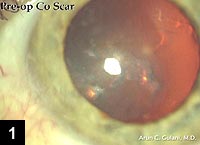 Slit-lamp view of the preoperative appearance of the cornea displaying the supra-Bowman’s layer scar involving a large area of the cornea. Images: Gulani AC
| 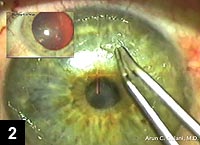 The corneal scar being mechanically peeled from the corneal surface after removal of the corneal epithelium. |
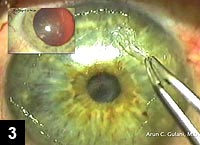 Mechanical removal of the corneal scar under the excimer laser. | 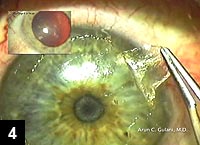 View of the corneal scar being removed mechanically from the corneal surface. |
The first step is to mechanically remove the surface corneal epithelium in all four quadrants using a blunt spatula, taking care not to damage the Bowman’s layer. The region of the cornea with the scar or lesion is the last area of epithelial removal. The movement of the spatula is tangential to the scar edge when removing the corneal epithelium in the region of the scar. Upon removal of the corneal epithelium, the margins of the scar become more visible and better defined. In cases of very thin scars, one can gently dimple the corneal surface, and this will help better define the borders of the scar. To assist in this surface corneal dissection, the magnification may be increased to more than 1.6 times on the oculars of the laser (Figure 1). Next, using thin-edge forceps, the edge of the superficial scar is gently “teased off” in a movement 90° to the long axis of the scar edge (Figure 2). Moving from one edge of the scar to another (Figure 3), the full length of the scar edge is lifted without tearing the margin. The scar is then lifted using blunt, smooth forceps, and it is peeled off the corneal surface (Figure 4). This manner of dissection facilitates removal of the entire scar without tearing or fragmenting the scar and also avoids the creation of any false planes. This avoids damage to the underlying cornea and thus avoids surgically induced corneal astigmatism. The surface of the cornea is then wiped clean using sterile Weck-Cel cellulose sponges (Medtronic), revealing a uniform, smooth corneal surface.
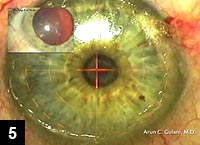 View of the cornea after the PRK treatment. |  Application of mitomycin-C 0.02% to the central cornea. |
 Immediate postoperative view of the cornea after combined mechanical removal of the corneal scar and PRK surface ablation of the cornea. | 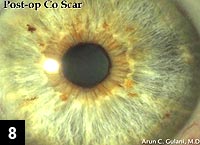 Postoperative view of cornea after mechanical removal of the corneal scar and PRK surface ablation. Cornea is clear with smooth epithelial layer. |
Excimer PRK is now started after confirming good centration and active tracking to correct the planned refraction, always using the largest optical zone possible (Figure 5). Mitomycin-C 0.02% is then applied for 30 seconds to the central cornea (Figure 6), avoiding spill over to the conjunctiva by using additional Weck-Cel cellulose sponges to dry off any excess mitomycin. This is followed by copious irrigation with sterile balanced salt solution, and at this time, a circular light reflex is visible (Figure 7). The corneal clarity and the circular reflex is a good endpoint for this procedure. A bandage soft contact lens (Acuvue, Oasys) followed by a drop of artificial tear and moxifloxacin 0.5% are applied to the corneal surface.
After the combined mechanical superficial scar removal and excimer laser treatment of the cornea, the surface defect heals with renewed epithelial layer over a smooth, intact Bowman’s layer. The cornea is clear without any scars, and the patient has excellent uncorrected visual acuity of 20/20 after this procedure (Figure 8).
Surgical pearls
- I do not recommend using sharp instruments on the cornea, ie, blades for lamellar separation, as they can cause false planes and irregular astigmatism. Blunt, fine-tipped forceps and blunt, multifunctional lamellar separators are used. Supra-Bowman’s lesions in the cornea will usually separate themselves from underlying cornea by gentle dissection as described above.
- Gently nudge the edge of the scar, and this will help in finding the edge. Use high magnification in the oculars of the excimer laser as needed.
- Keep the cornea dry at all times during the identification of the edges of the scar and subsequent dissection.
Postoperative treatment
Postoperative medications are continued as moxifloxacin 0.5% twice a day for 1 week, Nevanac (nepafenac ophthalmic suspension 0.1%, Alcon) twice a day for 1 week and Maxidex (0.1% dexamethasone, Alcon) four times a day and tapered over 3 weeks.
For more information:
- Thomas John, MD, is a clinical associate professor at Loyola University at Chicago and is in private practice in Tinley Park and Oak Lawn, Ill. He can be reached at 708-429-2223; fax: 708-429-2226; e-mail: tjcornea@gmail.com. Dr. John has no direct financial interest in the products discussed in this article, nor is he a paid consultant for any companies mentioned.
- Arun C. Gulani, MD, founding director of Gulani Vision Institute, can be reached at 8075 Gate Parkway West, Suite 102, Jacksonville, FL 32216; 904-296-7393; fax: 904-296-0393; e-mail: gulanivision@gulani.com; Web site: www.gulanivision.com. Dr. Gulani has no direct financial interest in the products discussed in this article, nor is he a paid consultant for any companies mentioned.
References:
- Gulani AC, Holladay J, Belin M, Ahmed I. Future technologies in LASIK- Pentacam advanced diagnostic for laser vision surgery. In: Experts Review of Ophthalmology, London; 2008, (In Press).
- Gulani AC. A New Concept for Refractive Surgery: Corneoplastique. Ophthalmology Management. 2006;57-63.
- Gulani AC. Corneoplastique: Art of Vision Surgery. Video Journal of Cataract and Refractive Surgery. 2006;Vol. 22:Issue 3.
- Gulani AC. Corneoplastique. Techniques in Ophthalmology. 2007;5(1):11-20.
